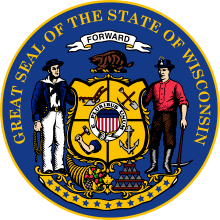Iron County, Wisconsin
| Iron County, Wisconsin | |
|---|---|
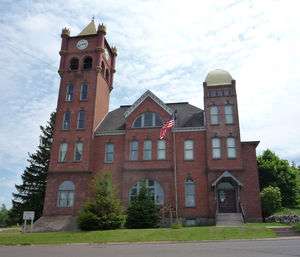 The Old Iron County Courthouse (now the Iron County Historical Museum) in Hurley, Wisconsin. | |
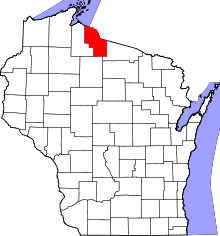 Location in the U.S. state of Wisconsin | |
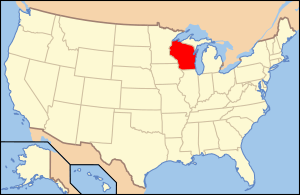 Wisconsin's location in the U.S. | |
| Founded | 1893 |
| Seat | Hurley |
| Largest city | Hurley |
| Area | |
| • Total | 919 sq mi (2,380 km2) |
| • Land | 758 sq mi (1,963 km2) |
| • Water | 161 sq mi (417 km2), 18% |
| Population | |
| • (2010) | 5,916 |
| • Density | 7.8/sq mi (3.0/km2) |
| Congressional district | 7th |
| Time zone | Central: UTC−6/−5 |
| Website |
www |
Iron County is a county located in the U.S. state of Wisconsin. As of the 2010 census, the population was 5,916,[1] making it the third-least populous county in Wisconsin. Its county seat is Hurley.[2] It was named for the valuable iron ore found within its borders.[3][4]
Geography
According to the U.S. Census Bureau, the county has a total area of 919 square miles (2,380 km2), of which 758 square miles (1,960 km2) is land and 161 square miles (420 km2) (18%) is water.[5]
Adjacent counties
- Vilas County - east, southeast
- Price County - southwest
- Ashland County - west
- Gogebic County, Michigan - northeast
Major highways
County Highways









Demographics
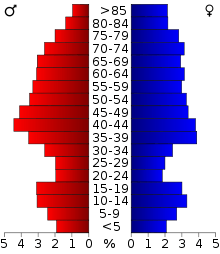
| Historical population | |||
|---|---|---|---|
| Census | Pop. | %± | |
| 1900 | 6,616 | — | |
| 1910 | 8,306 | 25.5% | |
| 1920 | 10,261 | 23.5% | |
| 1930 | 9,933 | −3.2% | |
| 1940 | 10,049 | 1.2% | |
| 1950 | 8,714 | −13.3% | |
| 1960 | 7,830 | −10.1% | |
| 1970 | 6,533 | −16.6% | |
| 1980 | 6,730 | 3.0% | |
| 1990 | 6,153 | −8.6% | |
| 2000 | 6,861 | 11.5% | |
| 2010 | 5,916 | −13.8% | |
| Est. 2016 | 5,726 | [6] | −3.2% |
| U.S. Decennial Census[7] 1790–1960[8] 1900–1990[9] 1990–2000[10] 2010–2014[1] | |||
As of the 2010 United States Census, there were 5,916 people residing in the county. 97.9% were White, 0.6% Native American, 0.3% Asian, 0.1% Black or African American, 0.2% of some other race and 0.9% of two or more races. 0.6% were Hispanic or Latino (of any race). 22.9% were of German, 13.7% Italian, 12.6% Finnish, 8.2% Polish, 6.6% American and 5.4% Irish ancestry.[11]
As of the census[12] of 2000, there were 6,861 people, 3,083 households, and 1,960 families residing in the county. The population density was 9 people per square mile (4/km²). There were 5,706 housing units at an average density of 8 per square mile (3/km²). The racial makeup of the county was 98.28% White, 0.09% Black or African American, 0.60% Native American, 0.13% Asian, 0.04% Pacific Islander, 0.06% from other races, and 0.80% from two or more races. 0.66% of the population were Hispanic or Latino of any race. 20.9% were of German, 18.6% Italian, 15.2% Finnish, 9.3% Polish and 6.4% Irish ancestry. 97.1% spoke English as their first language.
There were 3,083 households out of which 22.20% had children under the age of 18 living with them, 53.00% were married couples living together, 7.00% had a female householder with no husband present, and 36.40% were non-families. 32.00% of all households were made up of individuals and 16.30% had someone living alone who was 65 years of age or older. The average household size was 2.19 and the average family size was 2.74.
In the county, the population was spread out with 19.40% under the age of 18, 5.90% from 18 to 24, 24.70% from 25 to 44, 26.80% from 45 to 64, and 23.20% who were 65 years of age or older. The median age was 45 years. For every 100 females there were 96.10 males. For every 100 females age 18 and over, there were 96.80 males.
Communities

Cities
Towns
Census-designated places
Unincorporated communities
Politics
From 1928 to 2008, Iron County voted Democratic in presidential elections, the only two exceptions being Richard Nixon in 1972 and George W. Bush in 2000. Beginning in 2012, Iron County became a swing county, with Mitt Romney winning the county by 8 votes. The county gave 59.2% of the vote to Trump in the 2016 election.
| Year | Republican | Democratic | Third parties |
|---|---|---|---|
| 2016 | 59.2% 2,081 | 36.3% 1,275 | 4.5% 157 |
| 2012 | 49.3% 1,790 | 49.1% 1,784 | 1.6% 58 |
| 2008 | 42.7% 1,464 | 55.8% 1,914 | 1.6% 54 |
| 2004 | 48.6% 1,884 | 50.4% 1,956 | 1.0% 39 |
| 2000 | 49.4% 1,734 | 46.2% 1,620 | 4.4% 153 |
| 1996 | 35.7% 1,260 | 48.9% 1,725 | 15.5% 546 |
| 1992 | 32.7% 1,273 | 45.3% 1,762 | 22.0% 856 |
| 1988 | 43.0% 1,599 | 56.3% 2,090 | 0.7% 26 |
| 1984 | 45.6% 1,667 | 53.9% 1,967 | 0.5% 19 |
| 1980 | 45.0% 1,811 | 48.3% 1,941 | 6.7% 269 |
| 1976 | 35.3% 1,340 | 63.1% 2,399 | 1.6% 61 |
| 1972 | 49.9% 1,723 | 47.8% 1,648 | 2.3% 80 |
| 1968 | 34.3% 1,137 | 57.7% 1,913 | 8.0% 265 |
| 1964 | 27.7% 963 | 72.2% 2,514 | 0.1% 3 |
| 1960 | 30.9% 1,290 | 68.9% 2,873 | 0.2% 7 |
| 1956 | 46.2% 1,930 | 53.3% 2,226 | 0.5% 20 |
| 1952 | 39.2% 1,733 | 60.3% 2,662 | 0.5% 21 |
| 1948 | 30.4% 1,281 | 63.3% 2,665 | 6.3% 263 |
| 1944 | 31.5% 1,345 | 67.8% 2,894 | 0.7% 29 |
| 1940 | 31.7% 1,672 | 66.9% 3,525 | 1.4% 72 |
| 1936 | 20.8% 902 | 76.5% 3,319 | 2.8% 120 |
| 1932 | 25.3% 891 | 66.4% 2,338 | 8.4% 294 |
| 1928 | 40.7% 1,274 | 55.0% 1,724 | 4.3% 134 |
| 1924 | 40.2% 1,058 | 3.2% 84 | 56.6% 1,492 |
| 1920 | 77.7% 1,714 | 12.2% 268 | 10.2% 224 |
| 1916 | 54.6% 672 | 38.6% 475 | 6.8% 83 |
| 1912 | 40.0% 473 | 29.3% 347 | 30.7% 363 |
| 1908 | 73.9% 1,134 | 20.5% 314 | 5.6% 86 |
| 1904 | 81.1% 1,250 | 16.0% 246 | 2.9% 45 |
| 1900 | 76.8% 1,318 | 20.8% 356 | 2.5% 42 |
| 1896 | 72.0% 1,288 | 26.4% 472 | 1.6% 28 |
See also
References
- 1 2 "State & County QuickFacts". United States Census Bureau. Archived from the original on July 12, 2011. Retrieved January 21, 2014.
- ↑ "Find a County". National Association of Counties. Archived from the original on 2011-05-31. Retrieved 2011-06-07.
- ↑ Gannett, Henry (1905). The Origin of Certain Place Names in the United States. Govt. Print. Off. p. 166.
- ↑ "Here's How Iron Got Its Name". The Rhinelander Daily News. June 16, 1932. p. 2. Retrieved August 24, 2014 – via Newspapers.com.

- ↑ "2010 Census Gazetteer Files". United States Census Bureau. August 22, 2012. Retrieved August 5, 2015.
- ↑ "Population and Housing Unit Estimates". Retrieved June 9, 2017.
- ↑ "U.S. Decennial Census". United States Census Bureau. Archived from the original on May 12, 2015. Retrieved August 5, 2015.
- ↑ "Historical Census Browser". University of Virginia Library. Retrieved August 5, 2015.
- ↑ Forstall, Richard L., ed. (March 27, 1995). "Population of Counties by Decennial Census: 1900 to 1990". United States Census Bureau. Retrieved August 5, 2015.
- ↑ "Census 2000 PHC-T-4. Ranking Tables for Counties: 1990 and 2000" (PDF). United States Census Bureau. April 2, 2001. Retrieved August 5, 2015.
- ↑ "American FactFinder"
- ↑ "American FactFinder". United States Census Bureau. Retrieved 2011-05-14.
- ↑ Leip, David. "Dave Leip's Atlas of U.S. Presidential Elections". uselectionatlas.org. Retrieved 2018-08-13.
Further reading
- History of Iron County. Hurley, Wis.: Iron County WPA Historical Project, 1937-1938.
External links
- Iron County government website
- Iron County map from the Wisconsin Department of Transportation
- Iron County Economic Development
- Historic Bridges of Iron County
